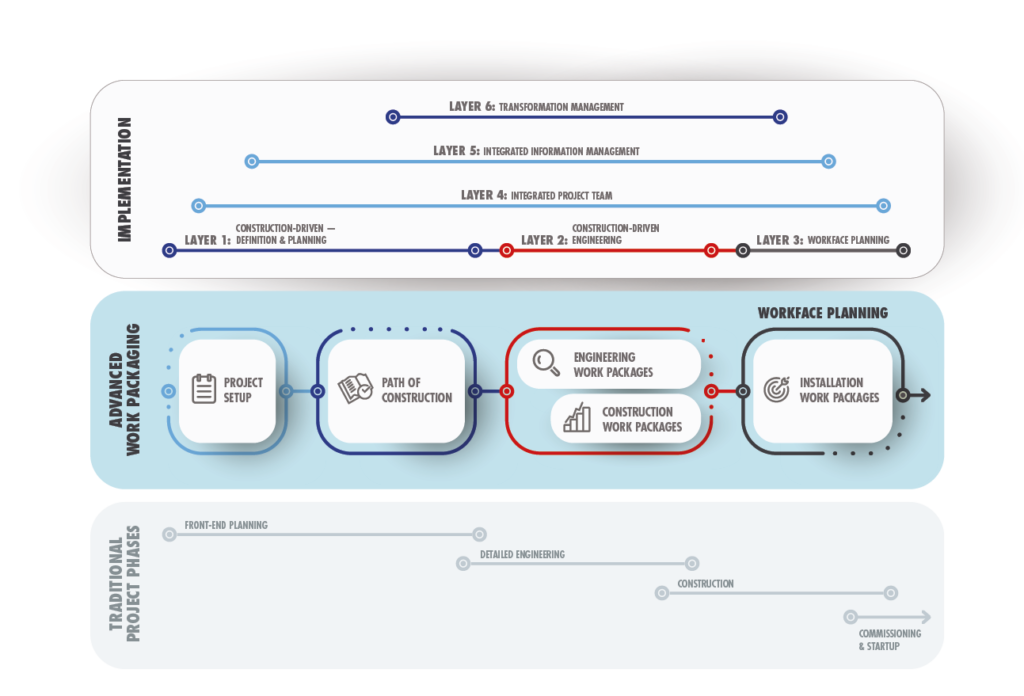To succeed at AWP implementation, get the right people in the right roles, with clear accountabilities and comprehensive training
So far in our Implementation Layers series we’ve talked about setting up systems and processes that support Advanced Work Packaging: construction-driven definition, planning and engineering followed by robust workface planning. Many companies and consultants stop here, operating under the mistaken belief that putting construction-driven practices in place is enough to guarantee success. It’s not.
In fact, here at Concord® we believe that instituting construction-driven systems and processes is just the beginning of your AWP implementation journey. In our experience, companies that succeed at AWP implementation take three additional steps: they integrate their team, harmonize information management and adopt professional, proven change management practices. In this article, we’ll explore the first of these three steps — the integrated project team.
Layer 4: Integrated Project Team
To implement Advanced Work Packaging, you need the right people in the right roles, with clearly defined responsibilities and accountabilities, and comprehensive training to support them in their efforts. Leaders must ensure that their team is prepared for, engaged in and supportive of the transition to a construction-driven project execution strategy. Nothing will undermine your efforts faster than a team that is not on board.
In the next few sections, we’ll take a look at what an integrated team looks like in the context of the first three layers. It’s important to note that we’re only able to cover the very basics in a short article like this; when we work with clients, we leverage a wide array of management and process tools to implement Layer 4. People and projects are complex, and this is just a simple introduction to the basics.
Integrated Construction-Driven Definition and Planning
Layer 1 is construction-driven definition and planning. What does an integrated project team look like at this level? In short, if you want to be successful in implementing construction-driven definition and planning, you must have your construction people in the room when you’re doing it. Many organizations already involve construction at this phase, but the engagement is superficial. Often, the role of construction leadership is reduced to offering an opinion on decisions that have already been made. This is not enough.
Real integration means finding the person who will be accountable for construction down the road, bringing them into the definition and planning process from the very beginning, and giving them an active role and real authority. Organizations that successfully integrate construction leadership make sure that they’ve budgeted for the work of the accountable construction party. This is the bare minimum for integrating your project team at Layer 1.
Integrated Construction-Driven Engineering
How do you create an integrated project team at Layer 2, construction-driven engineering? Fundamentally, it means that your engineering team delivers drawings in a sequence that supports the Path of Construction and the work of the construction team.
Traditionally, a capital project engineering team delivers systems-based Engineering Work Packages (EWPs), and construction teams are called in at the end to accepting the EWPs and convert them into Construction Work Packages (CWPs). To integrate the project team, leaders must make construction the primary connection between the EWPs and CWPs.
Integrated Workface Planning
Establishing an integrated team around Workface Planning is one of the more complex tasks of Layer 4. In this segment we’ll focus on one of many possible perspectives: the role of the Workface Planner.
It is important for the entire team to understand the role of the Workface Planner. This can be achieved with comprehensive training and education that ensures that your entire team is up to speed on how the threads of construction-driven project execution come together at the Workface Planning stage.
Consider global energy leader Shell, which required all of the staff at its Deep Water Gulf of Mexico portfolio to complete Concord®’s Workface Planning Certification. The leadership understood that in order for Workface Planning to be successful, they had to train every single person in the fundamentals. Now that everyone understands the role of the Workface Planner, they can collaborate more effectively, provide accurate information and facilitate the creation of high quality Installation Work Packages.
Some Closing Thoughts
Once again, it’s important for us to reiterate that this article doesn’t capture all of the ways in which successful organization work to create integrated teams across the first three layers of Concord®’s AWP implementation strategy. However, it does give you some practical insight into how to think about Layer 4 in the context of your first three layers.
If you’re interested in learning more about implementation layers, or if you want to use Concord®’s proprietary approach in your own AWP implementation journey, please contact us today.
Read the first four parts of this series:
An Introduction to Advanced Work Packaging Implementation Layers
AWP Implementation Layer 1: Adopt Construction Driven Definition and Planning
AWP Implementation Layer 2: Embrace Construction-Diven Engineering






